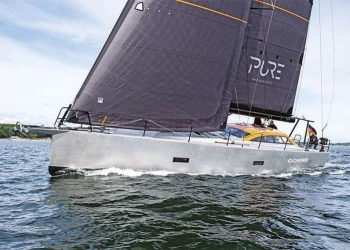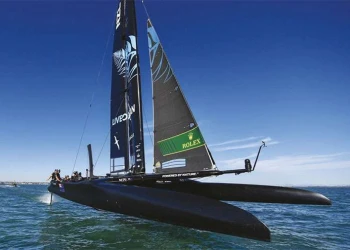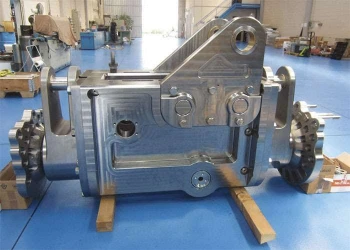
The canting-keel Elliot 52 Rafale, which broke the course record of the Aegean 600 Race last year, is one of many racing yachts that depend on Sevenstar for safe, swift and reliable transport between regattas on different continents
Sevenstar Yacht Transport for racing teams with global ambitions
Examining what happens behind the scenes at Sevenstar’s Racing Yachts’ logistics division reveals the huge amount of work, knowledge and experience needed to reliably and safely ship raceboats of all types around the world. This is the domain of engineering and operations manager Max Stepanov, who is an operation colleague of Sander Speet, and whose skilled and experienced team includes marine engineers and naval architects. Many have worked in varied roles at Sevenstar , often starting on ships before transitioning to working ashore.
Before joining in 2016, Stepanov was a merchant navy officer for 20 years, including five as captain. His deputy, Sean Lines, is ex-Royal Navy and a former Sevenstar loadmaster – a role requiring a high level of qualification and in-house training. Marian Minoiu, an engineering project manager, is a naval architect and marine engineer with 25 years’ experience and deep understanding of all intricacies of cargo handling. Another engineering project manager, Rene Berger spent two decades as a deck and engineering officer and 15 as master mariner. He has degrees in marine operations and engineering.
The team’s extensive knowledge is put to use as soon as an enquiry is received. For instance, while Sevenstar has a stock of certified yacht cradles in strategically located warehouses around the globe, raceboats typically use their own. These can provide better support, but that’s not automatic and Stepanov says at this stage he sees cradles that don’t comply with the necessary standards on many occasions. The key problem is most cradles are intended for static loads in a boatyard, not dynamic loads from motions encountered at sea.
The first thing the Sevenstar team needs is, therefore, data about the boat and cradle. For much of this the yacht’s rating certificate may suffice, along with technical drawings and current photos of both cradle and boat. These photos help the team identify any apparent deviations from the original specification.
If the cradle is not up to scratch the in-house engineering team can send the client recommendations for modifications. With 3D structural engineering software they can quickly answer complex questions. ‘Twenty years ago, it might have taken a week to design a custom cradle,’ says Stepanov. ‘Now we can produce workshop drawings in two days.’
A further stage for Max’s team is to devise lifting and stowage plans for the deck of the ship, with the yachts positioned as efficiently as possible, while allowing space for movement when each one is lifted off its cradle. Once loaded, cradles are held in place by substantial stoppers welded to the ship’s deck – this is carried out as a custom operation for every sailing.
This focus on safety pervades all aspects of Sevenstar’s work. Briefings for loading and unloading operations start 24 hours in advance. Even at highly regulated ports that aren’t on a regular route, every part of the operation is overseen by Sevenstar’s own loadmasters, who have ultimate authority to suspend work if wind or sea state threatens safe and smooth handling.
The company also has a long-standing philosophy of continuous improvement, driven both by client feedback and through an internal process of debriefing and analysis. Head of racing yacht logistics, Sander Speet, an accomplished professional racer, says it’s a constantly evolving process, with a focus on making sure communications are ‘super clear and efficient.’
Sevenstar also has the benefit of a growing database covering every yacht shipped and any specific measures needed. This includes feedback from loadmasters, for instance on recommendations for strop length for each boat. Such attention to detail takes time and shipping is best booked as far in advance as possible. Nevertheless, when necessary, lead times can be surprisingly short. For a fully custom shipping Speet says it's usually a minimum of two weeks, but they have done rush custom jobs, typically for competitors in The Ocean Race and the Imoca 60 fleet, ‘with very, very little lead time.’
Sevenstar’s regular sailings on its own fleet of ships account for the overwhelming bulk of business and at times these can be booked as little as two days ahead, providing logistics are in place. The team’s ultimate goal is to make even the most ambitious racing schedules a reality and they therefore work closely with race teams to provide point-to-point transport that makes it possible to maximise the scope of their racing.





